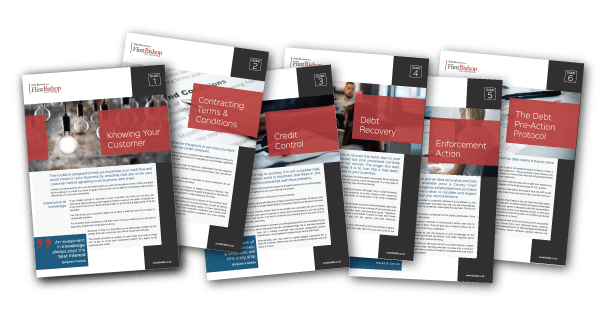The protocol problem
The world of credit is due to see a dramatic change on 1 October 2017 with the long-feared introduction of the new Pre-Action Protocol (‘PAP’) for debt claims. In his report on the subject, Lord Justice Jackson suggested that debtors are not being “fully informed” at the outset of debt claims and subsequently could not obtain proper legal advice. Despite much consultation of the credit industry and deliberation, there can be no doubt that this change in procedure has been geared heavily towards debtors and reducing the volume of cases brought before the Courts.
However, the introduction of the PAP may not be as bad as it first appears for creditors. Similar protocols have proven successful in fields such as Construction and Personal Injury, offering clarity as to what is expected prior to issuing legal proceedings and helping to narrow issues between parties without the need for litigation. The intention behind the PAP is that any dispute between a creditor and a debtor can be resolved without the need for Court involvement, reducing costs and the burden on the Court system.
Application of the protocol
The proposed PAP will apply to any business recovering a debt from any individual. Even if you only deal with business-to-business debts, you are not immune from the effect; ‘individual’ includes sole traders even on B2B contracts.
This means that it is now more important than ever that you know your customer at the time that you enter into a contract or agreement. Knowing your customer at an early stage can save significant problems later in collections activities, especially when it comes to time and costs due to the PAP.
It is also crucial that your customer’s status is monitored throughout your relationship, as they may incorporate their non-limited business or cease to trade as a limited entity without providing notice to you, which could save you a lot of paperwork and delay.
The protocol requirements
The proposals are all pre-legal, starting with the letter before action (LBA). Whereas an LBA is currently usually a standard 7-day warning letter, there is now a prescribed list of information that needs to be provided, including:
- A breakdown of the debt, interest and other charges claimed;
- The date of your contract with the debtor;
- Details of any assignment of the debt;
- An up-to-date statement of account;
- An explanation of how the contract came into being (whether written or verbal) and that a written contract can be provided if requested; and
- A reply form and financial statement form (compulsory annexed documents).
The LBA should also enclose one of the following documents:
- A statement of account; or
- An information sheet.
Timescales
The debtor is then allowed 30 days to reply before any Court action is taken. However, if the reply form is completed, another 30 days should be given and if the debtor requests and is subsequently provided with the written agreement, another 30 days are allowed. Although the timescales can overlap, a seasoned debtor may play the system to drag out the process without the fear of imminent Court action. In addition, a further 14 days’ notice should be given before commencing Court action if no agreement is reached.
After all that, you are then asked to stop and “take stock” to see if the PAP has worked and if proceedings can be avoided or the issues narrowed.
What are the Implications?
- Longer process;
- Increased administration costs; and
- Court process and costs. It has not yet been established if the Online Court is going to encompass the new process and so initially increased paper court costs may be incurred.
What are the Advantages?
- Less contractual disputes (in theory);
- Reduced back and forth correspondence with the debtor (in theory); and
- A clear procedure.
Sanctions for non-compliance
The Court may impose sanctions for non-compliance, such as costs sanctions, possibly a reduction in interest, or perhaps staying the claim. However, what seems apparent is that this is only ever going to be an issue if the debtor responds to the claim. If they ignore the claim, compliance with the protocol will not ever be questioned and you could obtain Judgment in default without the PAP ever becoming an issue. But is it worth the risk? Following the PAP every time might not make commercial sense. You need to weigh up the possible sanctions that could be imposed against the benefits of issuing proceedings prior to the 30 day response period.
You can, however, guarantee that with the topical advice forums that are available, many debtors will be well aware of their rights.
Things to consider
Knowing what the PAP introduces is only one part of the equation; as Darwin said: ‘it’s not the strongest of the species that survives, it’s the most adaptable to change’. If you adapt early and anticipate the changes that are needed, the effect on your costs and time expended to recover debt can be minimised.
It is an ideal opportunity to look into tightening and improving in-house credit control procedures. Creditors may wish to reduce the timescales of their overall credit control process and increase the number of early referrals to their legal partners, in order to deal with the requirements of the PAP and start the debt recovery process sooner.
The introduction of the PAP may also serve as a useful tool for creditors to consider all of the different options available to them. For example, bankruptcy or insolvency proceedings as an alternative; particularly where a matter is considered urgent and a more immediate action is required without the complications and delays of all the PAP stages and paperwork.
What steps can you take now?
Firstly, you need to be able to establish and capture certain items of data, either for your own records or for onward transmission to your legal partner. Based on the information available at present, these are:
- Trading style – is the debtor an individual, a sole trader or a limited company? The problem you may have is for older/existing accounts which have been simply set up in the business name i.e “MILWARD’S MOTORS”. Without inside knowledge, you have no way of knowing whether this is a partnership, a firm or a sole trader and this will need to be identified to establish whether the PAP applies. The suggested approach would be to assume that it does unless you can be sure otherwise.
- Dates – the date of any contract, oral or written needs to be identified and stored. For older accounts, this may be an issue, but it is worth putting a project in place to capture this data now, making sure that you always have it moving forward. Where contractual relationships have evolved over time, this may be problematic. However, if in doubt, go for the date of the order or orders to which the invoices relate.
- Copy documents – where there is a signed or written agreement and/or terms and conditions, these need to be easily stored and accessible upon request. The Court will not look favourably on a creditor who is unable to provide a document that they themselves seek to rely on.
Consider your current collection procedures
It would make a lot of sense to think about your current processes and procedures now and identify what you may be able to improve. For example:
- Should you shorten your payment terms now and review your credit application/agreement process internally?
- Should you reduce your credit control cycle? We often come across companies who send 4 or more dunning letters over an extended period.
- Should you train/refresh all staff to ensure that all contracts are fully completed and ensure that all written agreements/calls (any other voice recordings) are stored and easily accessible?
The above suggestions can all reduce delays in the process between providing the service and recovering the payment. For example, if you reduced your payment terms by 7 days, chased immediately rather than on 7 days overdue and sent 2 reminders rather than 3, you could have already gained 21 of the 30 days that the PAP adds on. Subtle changes will make a massive difference.
In addition, just because the PAP is effective and you cannot chase the debt in the protocol period, that does not mean that all activities must stop. For example, instead of chasing the debt by telephone, you could call to check that the debtor has received the protocol LBA and whether or not they need anything else. This keeps some pressure on the debtor without falling foul of the protocol; after all, such measures are within the spirit of communication and cooperation with the debtor.
Alternative dispute resolution (ADR)
ADR procedures, such as mediation, can reduce the number of disputed debt claims progressing to litigation and may lead to more matters being resolved without the cost of issuing Court proceedings. Early disclosure of documents may well help some debtors to understand why the debt is owed and agree to make payment. Sometimes a face-to-face meeting (where appropriate) can alter the entire tone of a conversation, which if set down in correspondence has a more abrasive and harsh meaning. On the odd occasion, there will be a debtor who just wants to have their voice heard and engaging with them may prevent escalation to their day in Court.
Conclusion
The important thing is not to panic, but to prepare now rather than mid-September. You should come up with a plan of action on how to tackle this asap, and how you might use the changes to your benefit. Whether it is to reduce queries and bad debts or make sure that your practices are watertight – it can only be good from an audit or customer journey point of view. With the right preparation and advice, you can turn a potential problem into something that works for your business.
For more information, please contact us on 01332 226 474 or email: .
|
|



